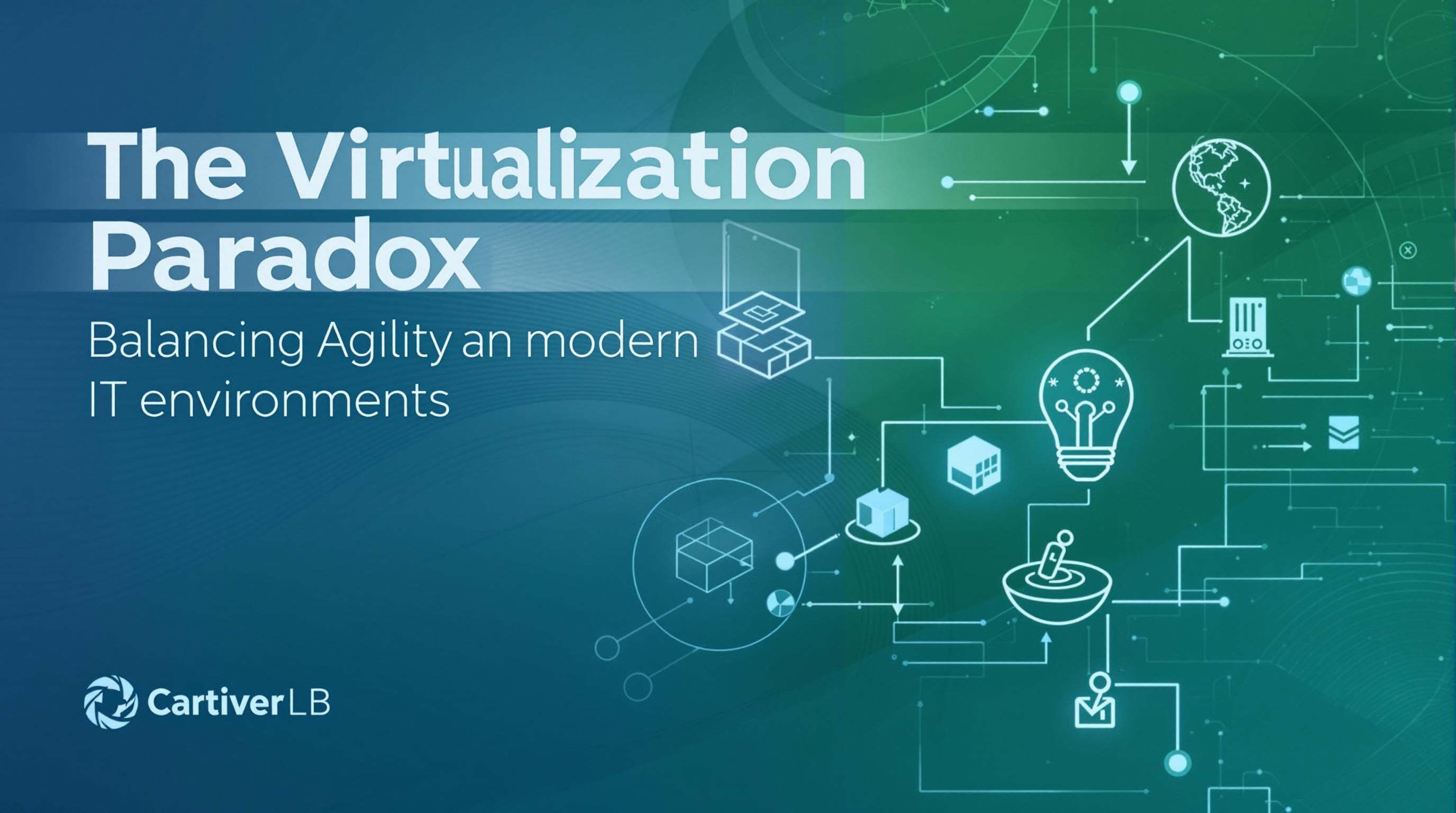Related Articles
- Uncharted Realms: Unveiling Serverless’ Role in Revitalizing Local Economies and Microbusiness Ecosystems
- Unearthing Surprising Synergies: How Serverless Solutions are Reinventing Events and Experiential Marketing Strategies
- Serverless Beyond the Cloud: Unpacking Its Role in Wildfire Management and Ecological Restoration Efforts
- Harnessing Digital Detox: Unplugging to Unleash Creative Energy and Ignite Workplace Performance
- The Surprising Role of Aroma: How Scents Can Unleash Hidden Productivity Boosts in Your Workspace
- Unlocking the Power of Serendipity: How Chance Encounters Can Enhance Team Productivity and Innovation
The Virtualization Paradox: Balancing Agility and Complexity in Modern IT Environments
The Virtualization Paradox: Balancing Agility and Complexity in Modern IT Environments
The world of IT is at a crossroads where virtualization promises unparalleled agility, yet introduces an overwhelming level of complexity. This article explores the virtualization paradox, discussing its impact on modern IT environments, the balancing act required, and strategies to navigate through this intricate landscape.
The Rise of Virtualization
In the early 2000s, virtualization technology burst onto the scene with the promise of efficiency: cutting costs, optimizing resource usage, and streamlining service delivery. According to a report by Gartner, organizations that embraced virtualization reported a 50% reduction in hardware costs and a 70% decrease in energy consumption. It was a game-changer, transforming the way IT departments operated.
Embracing Agility
Agility in IT has become synonymous with success in today's fast-paced digital economy. The ability to spin up new virtual machines (VMs) or containers in minutes—rather than days—enables organizations to respond to customer demands swiftly. For instance, during the COVID-19 pandemic, many businesses turned to virtualization to support remote work almost overnight. With cloud services like AWS and Azure, companies could now focus on their products and services rather than managing backend infrastructure.
Statistics That Speak Volumes
According to a study by IDC, nearly 70% of organizations have adopted some form of virtualization. However, with great power comes great responsibility—this newfound agility leads to a surge in complexity.
The Double-Edged Sword of Complexity
While virtualization offers remarkable benefits, managing a virtual environment can feel like trying to juggle flaming torches. Consider a typical organization that operates hundreds or thousands of VMs; managing their configurations, dependencies, and security aspects is no small feat. A report by 451 Research found that 60% of IT leaders identified complexity in managing their virtual infrastructure as their top concern.
Case Study: The Complexity of Cloud Migration
Let’s look at a fictional case study of a retail chain, ShopSmart. They decided to migrate their operations to a cloud-based virtualization platform. Initially excited about the promise of agility, they soon faced various challenges—including performance issues, compliance risks, and difficulties with vendor lock-in. They discovered that not only were they spending more time troubleshooting problems, but their staff's productivity dropped as constant reconfigurations became necessary. This scenario highlights a central tenet of the virtualization paradox: the more you virtualize, the more you have to manage.
Strategies for Maintaining Balance
So, how do organizations mitigate this complexity? Let's dive into some effective strategies.
1. Prioritize Automation
Automation is your friend in the world of virtualization. Tools like Ansible, Terraform, and Kubernetes can help automate deployment processes, reducing the potential for human errors and freeing up IT staff to focus on innovation rather than mundane tasks. According to a survey by Puppet, organizations that fully embrace automation see deployment times decrease by more than 80%.
2. Invest in Training
It's easy to overlook the human element in technology adoption. As virtualization technology evolves, continuous training is essential. In the case of ShopSmart, one of their greatest missteps was overlooking the need for staff training. Investing in comprehensive training programs not only empowers employees but also leads to reduced troubleshooting time and higher productivity.
3. Implement Robust Monitoring Solutions
Monitoring tools help demystify virtualization environments by providing valuable insights. By employing solutions that track performance metrics and system health, IT teams can preemptively identify issues before they escalate into critical problems. This proactive approach can save organizations from becoming ensnared in a web of complexity.
Common Pitfalls to Avoid
As with any powerful tool, there are traps that organizations might fall into when adopting virtualization. Here are a few common pitfalls:
1. Over-Provisioning Resources
It might be tempting to provision more resources than needed, but the added complexity can lead to inefficiencies. As Stewart Brand famously said, "Information wants to be free," but don't forget that over-provisioning can lead to skyrocketing costs. Keep it lean for better stability.
2. Ignoring Security Best Practices
As organizations virtualize more resources, security can take a back seat. Remember the infamous Target data breach of 2013? The company’s failure to secure its virtualized environment led to the theft of a whopping 40 million credit card numbers. Organizations must incorporate security at every level of their virtualization strategy.
Humor in Virtualization
Indeed, virtualization isn’t all doom and gloom. Sometimes programmers feel like they're juggling flaming torches while balancing on a unicycle. Ever heard of the IT professional who said, “I don’t write bugs; I create undocumented features?” In the grand circus of virtualization, humor can often be the best tool to cope with daily complexities.
Pros and Cons—The Balancing Act
Ultimately, virtualization is a balancing act. There are perks, like agility, cost savings, and scalability, but the downside often involves heightened complexity and management overhead. Recognizing these pros and cons allows organizations to make informed decisions.
A Story of Transformation
Once upon a time in Silicon Valley, there was a startup named TechTonic. Like many new companies, they jumped onto the virtualization bandwagon, totaling up to 300 VMs within a year. Their development teams could deploy at lightning speed, but the inevitable happened—a bureaucratic nightmare ensued. With no overarching management structure, conflicts arose over resource allocation, leading to a breakdown in operations. The CEO, realizing the chaos, had to pivot. They reduced their VM count, automated many processes, and implemented a centralized management approach. While it took some time to stabilize, the initial chaos ultimately spurred their innovation and turned TechTonic into a market leader.
In Conclusion
The virtualization paradox—balancing agility and complexity—is a challenge faced by most modern IT environments. By understanding the risks and employing strategies like automation, proper training, and robust monitoring, organizations can successfully navigate this intricate landscape. The key takeaway is no different than life itself: adapt, learn, and thrive—even when juggling those proverbial flaming torches.
In an age where time is money, mastering virtualization could very well be your golden ticket to staying relevant. Remember, whether you're a seasoned IT veteran or just starting in the tech world, the journey through the virtualization maze isn't just about technology—it's about the stories you'll tell along the way.





